What’s the difference between Virginia creeper and False Virginia creeper?
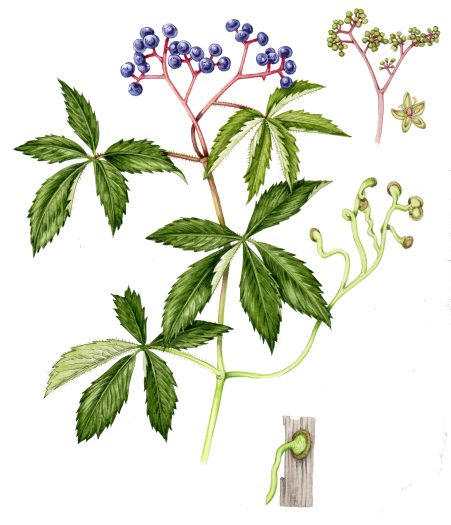
Virginia creeper Parthenocissus quinquefolia and False Virginia creeper Parthenocissus inserta are common and decorative. They are favourites with gardeners, who train them to grow up walls of houses and pubs where they give cover and autumn colour. They’re vigorous climbers, deciduous, perennial, and develop woody stems.
They are also classed as an invasive plant species in the UK as they can swamp trees and bushes. Coupled with this, their berries are poisonous and may cause blistering and rashes.
But how can you tell these two similar species apart?
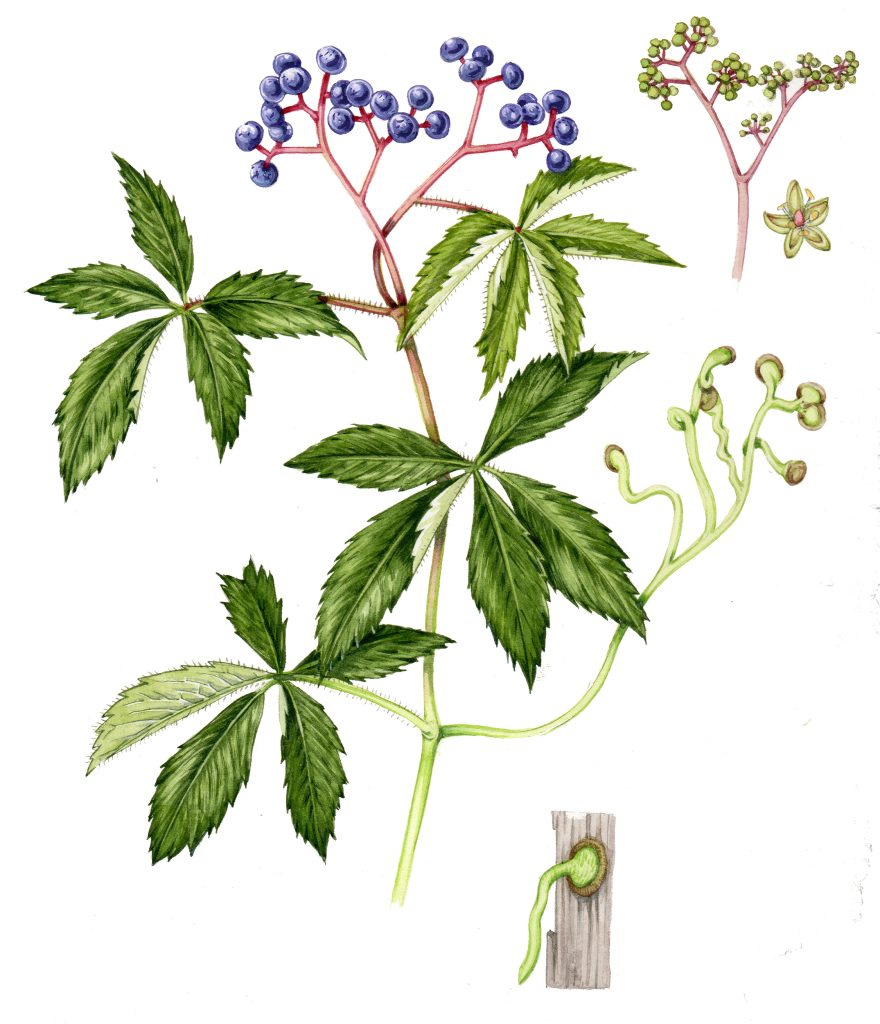
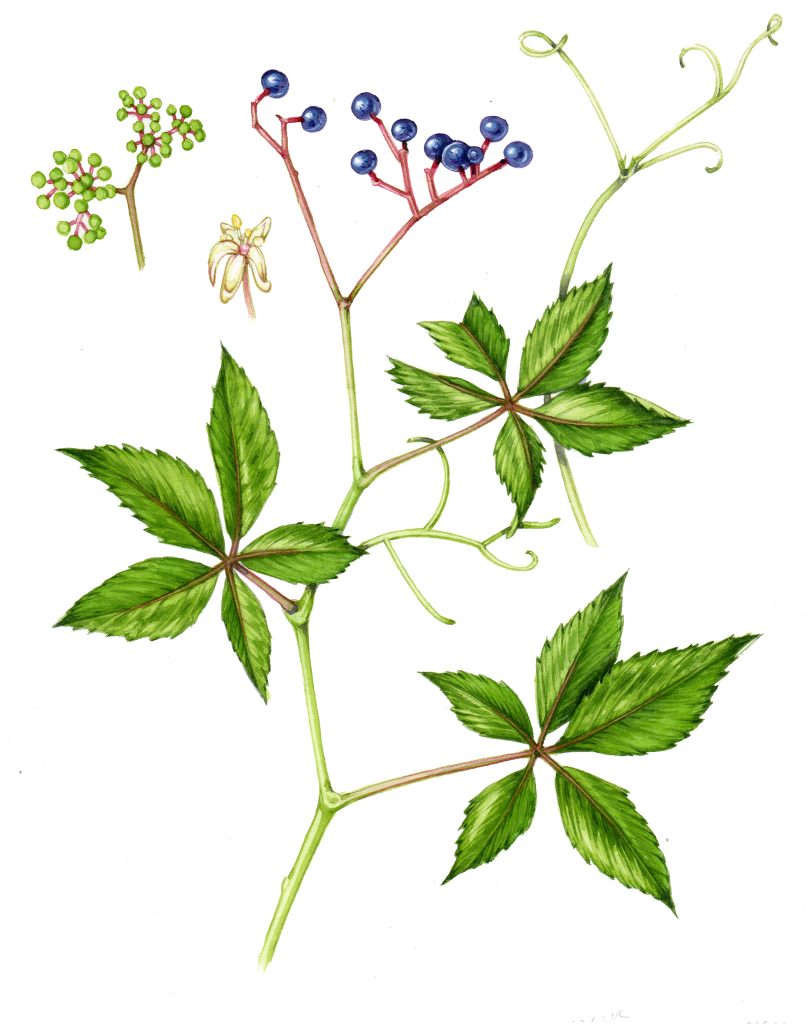
Virginia creeper above and False Virginia creeper below
Virginia creeper and False Virginia creeper both have palmate leaves, made from five leaflets. With the former, these have hairy leaf stalks. The latter has smooth stalks. Virginia creeper leaves are a dull green, with hairs on the underside and on the veins. False Virginia creeper leaves are a brighter and shinier green, and are glabrous (hairless) underneath. The teeth on the leaf margin differ too. the former has coarse teeth, the latter has sharper dentition.
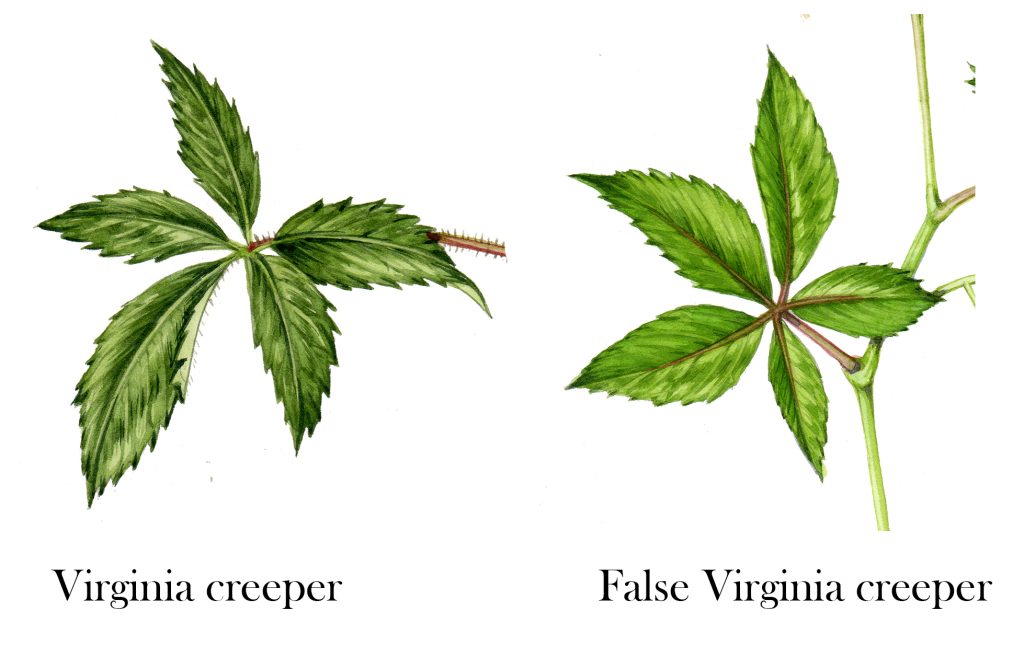
Comparing species: Flowers
Flowers of both species are small and greenish, in fact, you may never have noticed them. With Virginia creeper, there are more flowers per cluster, and they come from a clearly defined central stalk. With the False creeper, the flowers are smaller, less green, and have strongly reflexed petals. This is a diagnostic. Both species have flowers with creamy yellow anthers.
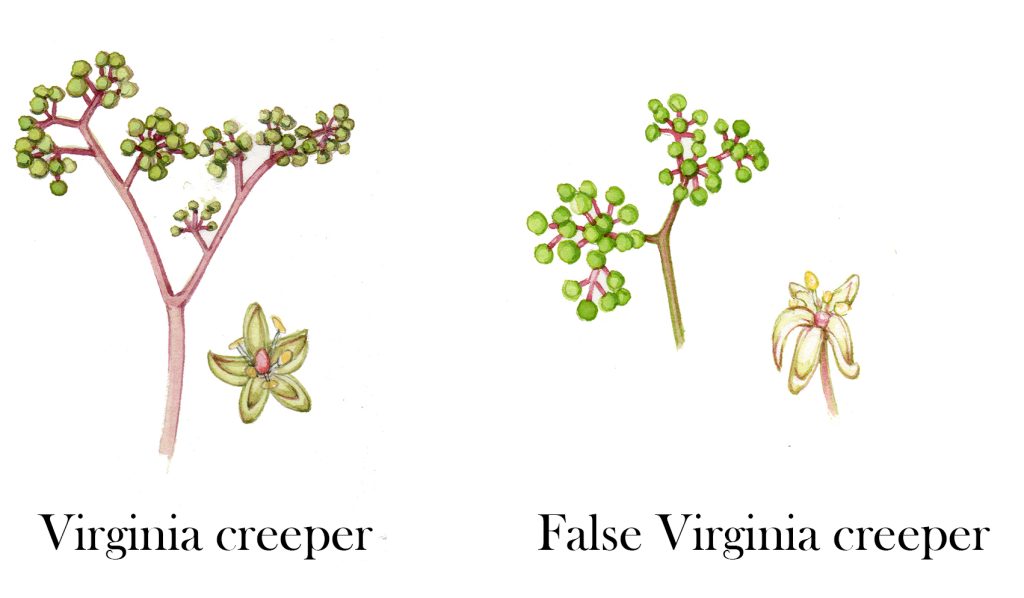
Comparing species: Fruit
The fruit aren’t much help to us, to be honest. Both species have blue-black berries, borne on a stem flushed red. They may have bloom. The berries of the False creeper grown in a “dichotomously branched bunch” (which seems to mean there’s no clear central axis) but I think it’d be tough to tell them apart by fruit alone.
Comparing species: Stems
The Virginia creeper has a pale brown stem, with non-flaking bark. In the False creeper, the stem is clearly swollen at the nodes. It doesn’t have flaking bark. You can also detect pale lenticils which are absent in VA creeper.
Comparing species: Tendrils and suckers
This is the give away when it comes to telling these plants apart. The Virginia creeper has tendrils which branch 5 to 8 times, and are stursy. Vitally, each tendril terminates with an adhesive disc. These suckers act like glue-pads, helping the plant attach and climb up the substrate. They’re instantly visible, even in winter, as dark discs at the end of each tendril.
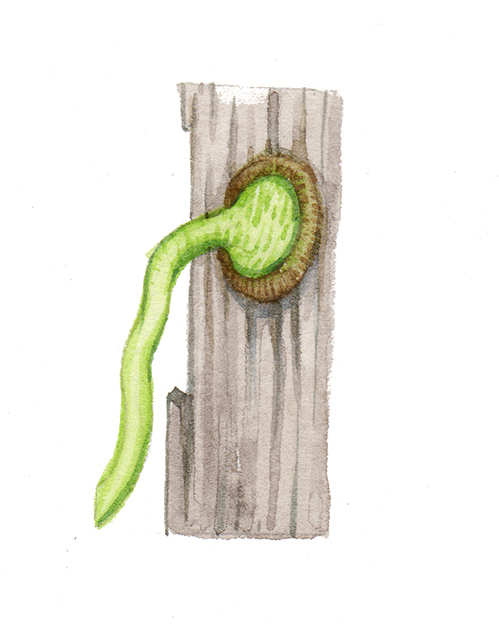
Virginia creeper sucker
False Virginia creeper also has tendrils. these are far less divided, with only 3 to 5 branches. There are no adhesive disks. the tendrils terminate in an elegant thin tip.
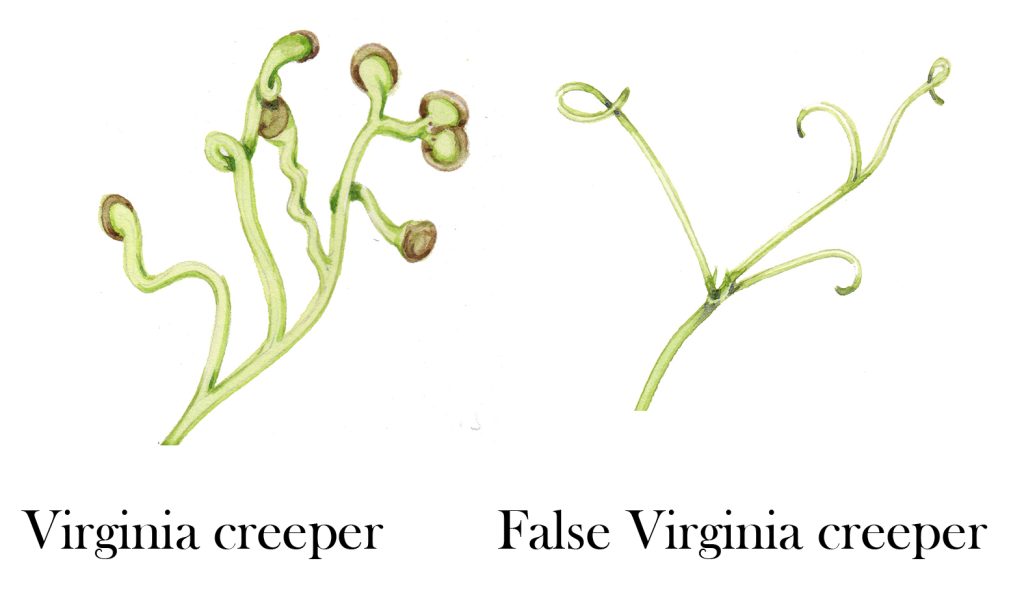
Conclusion
The easiest way to separate these two similar species is to look for the tendrils. Suckers mean it’s Virginia creeper, no suckers mean you have a False Virginia creeper. Failing this, look for leaf colour and hairiness, and whether the flowers are reflexed or not.
But in either case, enjoy the brilliant scarlet and crimson colour that these leaves turn when autumn comes around.
For a blog on how to paint the leaves of the False Virgina creeper click here. Useful resources for this blog have included “Invasive Plant and Animal Species of Britian” by Booy, Wade, and Roy; and various pages which mostly are keen to differentiate between Virginia creeper and Poison ivy (like this one from Dave’s Garden).


This is an excellent page with clear and accurate descriptions and beautiful drawings.
I think people should be warned that Virginia Creeper (Parthenocissus quinquefolia) is invasive and that some people are sensitive to the sap. The berries are, of course, poisonous.
My neighbour has this growing on his property but next to my outbuildings, in Norwich, England, UK. It has invaded around three sides, come through a solid wall, pops up everywhere nearby and is completely uncontrollable. I used to think it was beautiful in autumn, climbing over my roof; that was, until it pulled tiles off!
Just over a week ago, I was pulling out the stuff and a bit of sap went on my arm, which I quickly wiped off, not realizing that some was also on my leg. My arm came up in a red blotchy sore, but my mid-calf had what looked like a blood-blister initially, but which quickly spread in a swollen red patch down to my foot. I had a lot of insect bites, too, which were itchy. The sap-infected arm and leg were painful but not itchy, and after a few days the whole of my lower leg and most of my foot were bruised and swollen. I had to visit the doctor, who has put me on antibiotics and antihistamine and now, after more than a week, it is starting to clear up, but is still quite painful.
People thinking of planting this stuff should be aware of what they are getting into!
Hi Heather, thank you so much for this warning. Sounds like you had a truly horrible reaction to the sap, and thank you for alerting us to its dangers. Yes, it does come in as an “invasive” but you’re right, it seems to be one that can damage buildings too, and should indeed come with some sort of warning. I do so hope your leg and arm get better soon – I’m amazed and so sorry that it needed antihistimine and antibiotics to help start to clear it, poor you! Thanks again for your extremely relevant comment!
I think I had the same thing happen, I had no idea this reaction would happen from touching this vine. I had some bug bites but this itch would have gone away by now. I keep putting anti itch spray on my arms
Hi Maribel
Extraordinary! Never heard of it before. Possibly a phytotoxic response, sometimes sap plus bright sunlight does all sorts of dreadful things?
thanks for the comment and hope it clears up soon.
yorus
Lizzie
I am trying to find out what plant I have, it looks like Virginia creeper or false Virginia creeper, however there are no berries on it. It is also invasive, although I like where it is. Can you steer me in a direction of another plant that looks very similar but without berries?
Hi Gwen
Hmm. The partheocissus genus has tons of different species in it, all are climbers and really good at colonising places. This one page summary from Oxford Plants gives some idea of what we’re up against in getting a defintie i.d: https://herbaria.plants.ox.ac.uk/bol/plants400/Profiles/OP/Parthenocissus What you could do is take a photo and tweet it to a couple of botanical gardens perhaps? Or if you have a decent garden centre nearby take a cutting and go in and ask to see their plant expert? Im assuming its been year round without berries. It rather complicates things, the lack of berries, but for an expert could be an absolute give-away as to the species you have. SOunds like you like it, so Id leave it exactly where it is! Sorry not to be more help, ah the pit-falls of being a keen amateur!
Thanks for the comment and for taking the time to ask
Yours
Lizzie
Lizzie,
Thank you for your very informative post! We just moved into our new house in New Mexico, USA about two months ago. The owners had informed us that there was a grapevine and the grapes were pretty good. After we moved in the grapes ripened and my husband informed me that there were actually two varieties, but that the red ones were really sour and bitter. Low and and behold come late September, the leaves on the yucky ones started to turn red, and I began to think that it looked a lot like Virginia Creeper which I have always loved from a distance and knew nothing about. That’s when I found your post. OMG! My husband ATE SOME of THOSE berries. What turns out to be false Virginia creeper, is growing right there entangled with our grapevine! Who would do that???? The must not have known anything about it, or it just voluntarily showed up. Thanks to your post we will be suiting up and getting out there to get rid of that dangerous creeper, even though it is very pretty. And to the person who commented about the berries being poisonous, “obviously”, well it’s not obvious to everyone. Thanks for the heads up!!
Oh Shelly, what an adventure! And I agree, its always easier to spot something dangerous with hindsight. In truth, I dont think the berries are lethal, they might just cause an upset stomach. But how confusing! Sounds like youd figured it out yourself, to be honest, by the fall colours.
I do hope you can still go on eating those grapes. And maybe dont get rid of the creeper, just make sure you know the difference between those crazy fruits! Sounds like your new house is utterly gorgeous, and enjoy settling in!
Thanks for letting me know, and so glad to have helped your husband avoid a stomach-ache!
X
OMG. We’ve just moved to NM, and have False Virginia Creeper planted amongst, trumpet vine and wisteria.
I only found out what it was becasue I saw the berries and hoped they were edible. Absolutely NOT edible except to birds. I now know to be careful trimming this too.
Thanks for the great post, Shelly, and the wonderful website and drawings Lizzie.
So pleased that its a good source of info, and especially pleased that the info shared by Shelly helps. I love feeling the sense of community you can get from blogging. Thanks for sharing this, Andy!
Hello! I just found the False Virginia Creeper in my backyard. I plan on a sizable vegetable garden next year, and I’m wondering if it would be useful as a bait plant. It houses a wide variety of insects and the local wildlife love it, so would it possibly help to have it around my fence line? Or work against me by attracting pests? I’m prone to think it would help, as these pests are already present, and quite abundant. Any and all advice welcome!
Hi Laura
Im no gardener, but I think it would help. If it doesn’t work as a bait plant then it’ll look beautiful and inspire you to spend long hours in the garden, which will benefit you AND the plants, right? I’ve certainly never heard anything that suggests that creepers are contra-indicated to a healthy garden plot, but as I say, Im not a very good gardener…
Enjoy your vegetables!
X
I like the helpful info you provide in your articles. I will bookmark your weblog and check again here frequently. Im quite certain I’ll learn many new stuff right here! Best of luck for the next!
So glad I found your post. I have heard Virginia creeper is terrific for wildlife. Do you know if that is true with false Virginia creeper?
Hi Patricia. Hmm. I have no actual idea. However, I would think it serves the same purpose. Thickets of leaves where you can nest/ crawl about/ scuttle and hide in comparative safely. Then networks of thick tendrils etc to curl up under or amongst during the winter. Not sure how good either plant is for pollinators, but I bet if Va Creeper is good for wildlife as a whole, false Va creeper would be too. they’re so similar, right? Thanks for the comment.
I’ve got a beautiful wisteria mixed with roses on a trellis. I’ve noticed False Virginia Creeper vines beginning to invade. They sprout leaves earlier than the wisteria or roses so are easier to identify in Spring. Should I remove them before they take over my trellis? Or will they simply co-exist adding more fall color. It took me years to grow the roses and wisteria.
Hi Deborah
Thats a good question, and I can see why you need to know – so much work with the roses and wisteria needs to be saved, if it needs to be saved. Unfortunately, Im an appaling gardener. the only plants that thrive in my garden are “weeds” I plant out after drawing them, and bulbs. I’m trying to think of who you might be able to ask for advice? A loical garden centre perhaps? Or does Kew or the RHS have an email address for enquiries? A local botanica garden would probably be able to advise you too. it’s a matter of getting the question under the right noses. Sorry not to be more use, and good luck. With or without the creeper, it sounds beautiful.
X
Remove it!!!! I’m living in creeper hell!!! It’s in my neighbor’s yard and continuously creeps into my yard! It is a constant vigil and a full-time job!! I’ve pulled miles of vines already this summer and there’s no end in sight!
Oh Cyndy, what a nightmare! You poor thing. And so frustrating that you cant really get to the root of the problem (no pun intended) as the plant is in the neighbours garden! Not such a lovely botanical specimen for you, and I totally understand why! x
It’s in my woods and I let it climb my house. Keeps it cooler in summer. I think mine is the false variation though. Double checking later. But just wondering why pull it all out. It’s very beautiful in the areas we have it and fairly simple to control.
It’s a funny thing, isn’t it? I tend to let stuff grow in my garden, and there is absolutely a level of chaos there which someone like my Dad would have hated. But I hope it’s good for wildlife. And although I do have pangs of jelousy about people with stripy lawns and perfect flower beds, I know I’d never be able to manage a garden like that! If the vine doubles as an insulator, that’s great1
I have this growing all over my porch and now my clothes line I don’t know what to do with it should I remove it it’s the Virginia creeping thing
Hi Debbie, I guess it’s up to you really. If you like it, leave it. the colours are lovely in autumn. If you dont like it, cut it down. Id say remove it from your clothes line unless you want leaves in your socks!
I heard spraying vinegar on it will kill it
Interesting. Sounds like it could be a good way to control it, and pretty environmentally friendly, too.
I tried saturating the young spring leaves in vinegar and they didn’t even wilt. This stuff is hardy!! Trying boiling water next as so don’t have much yet.
I love it when plants beat us trying to eradicate them. I feel the same about the dandelions in my mother’s paving slabs. Beastly, but so darned tenacious! I have to admire them.
I just cut the vines at the point I want them to stop in the fall. They don’t tend to cross often and if they do I double the vine back. But wild in my woods. No way of killing it all.
That#s what I do with the plants in my garden too. Controlled chaos! And as you say, if the vines are native to the surrounding area, it’s a war you’re unlikely to win unless you relax a little….
This is invasively growing over our back fence from back neighbors yard. It looked messy to me and I started removing it. Well one of the vines was hosting a ton of LANTERNFLY Nymphs. I live in Southern NJ (USA) and I’ve never seen this before. They started invading last year and well I guess they have now full on invaded!
Hi Melanie
Lanternfly? How exciting! Wow, I didnt know they were invasives. I just think the adults look so peculiar! I never saw any when I lived in DC back in the 80s, Im rather jelous! How interesting that theyre hanging out on your VA creeper. Do they damage the plants? Fingers crossed they wont bring doom and destruction to your garden. And thanks for letting me know, what a fascinating link. x
The Spotted Lanternfly is a destructive pest! Don’t encourage them! See –
https://extension.psu.edu/spotted-lanternfly
Wow! Kenneth, thank you! I had no idea. I’m just jealous cause it sounds dead exotic! Thanks for the link, and for taking the time to leave a comment!
If my Virginia creeper has invaded my loft,will it grow their even if I cut it all at a low level below ? Thanks.
Hi Helen
Oooh, there’s a question for a gardener. But if the roots are at ground level, then anything above the cut will die. Unless some seedlings have somehow sprouted at a higher level, or in amongst the nooks and crannies of the wall or loft. If you cut a plant off at its main stem below the troublesome growth then yes, it should just die back. Hope this helps, and good luck reclaiming your loft!
This is so well laid out and informative! Just shared on my BA&A FB Page!
Hi Katherine
Thanks so much! Your approval and sharing is a real vote of confidence. Thankyou.
It’s a funny thing, isn’t it? I tend to let stuff grow in my garden, and there is absolutely a level of chaos there which someone like my Dad would have hated.
Totally agree. Our dads were clearly made of the same cloth!
Does false Virginia creeper give you the same horrific blustery rash as real Virginia creeper?
Hi Lezlee
Gosh, I dont know! Id never heard of Virginia creeper causing rashes, but I don’t doubt your word for a moment. But I’m afraid I don’t know, I’d not heard of either causing rashes. Hope you’ve not suffered yourself!
yours
Lizzie
Made me know about the differerence between virginia creeper and false virginia creeper. Thanks
Thats great to hear, and thanks for leaving a comment.
I’ve had my Virginia Creeper for about 12 years now. It started off in a small pot and covers 3 x8ft high walls the length and breadth of my small yard. It’s starting to climb the wall of my white painted house which has had horrible crazing all over it since I moved in. The aim is for the creeper to cover a complete square around my yard and lower part of my house. It does invade my neighbours space at times but they just cut it back at chuck the cuttings over my wall. The local council came to talk to me about it a few years ago, but I told them that not only does it help my mental health, being surrounded by greenery, it also provides a valuable ecosystem for birds and insects. It’s not the only thing I grow in what would otherwise be just an area of brick and mortar. (If I’m making a tea I’ll use parts of the creeper with wild mint). The local council have never returned. I have so far not see any evidence of damage. All my walls are sandstone and the only thing I see when I cut it back or pull of parts to trail it, are marks left by the branches or sap. No damage whatsoever.
I’d advise anyone to grow one, but keep on top of it. It is easy to grow and will get out of hand if you just leave it. In winter, cut back some of the stems to the main branch if it’s going places you don’t want it to go. It will reward you with a stronger root, this is key when you (or workmen) have an accident and snag part of it in half. This will also help you ‘guide’ it to where you do want it to grow. Mine even covers a large root stump that’s too heavy to move.
Hi, this is lovely to hear, that youve embraced and encouraged your creeper and use it for so many things. Im really glad both your neighbour and the council are happy for you to keep it. And I have no idea you could make tea from it!
Thanks for this post. I also broke out in a terrible blustery rash that started off looking like bug bites. It’s still going strong after a week. I thought that somehow it was poison ivy, but I was targeting Virginia creeper (I believe mine is the false type) and didn’t see anything that looked like poison ivy. Next time I go into that area, I will be covered head to toe!
Poor you, Lori! SO sorry you got that rash, it sounds unpleasant.
Virginia creeper and False Virginia creeper may appear similar at first glance, but there are some key differences to look out for. Virginia Creeper (Parthenocissus quinquefolia) is a native vine known for its vibrant red fall foliage and five-leaflet compound leaves. On the other hand, the False Virginia creeper (Parthenocissus insert) has three-leaflet compound leaves and tends to have less intense fall colors. Additionally, the False Virginia creeper tends to attach itself more securely to surfaces with adhesive pads, while the Virginia creeper uses tendrils to climb. These subtle distinctions can be helpful in telling the species apart. Feel free to ask if you have any more questions about these fascinating plants!
Thanks for this extra information Alexandra, appreciate it
It says the opposite in the first communique , real VC has suckers and the false one just has tendrils that just stop.
Oh now I’ve gone and confused myself. I did find it super-tricky untangling the two when I was illustrating them. But yes, the suckers vs unanchored tendrils is the main give away.
I always follow your Blogs. They are very informative. I get information about various topics from them. I also want to share my blog with you. You will get information about the Arlo app from it. Thank you
I really hope there will be a lot more content like this. I am grateful that you shared your information with me. Your blog has been bookmarked because I discovered some extremely useful information on it.
Thanks you Musichd
This stuff is just as bad as poison ivy. I’m extremely careful when working out in the woods around my property not to come in contact with ivy,oak,or sumac. This being none if those I figured I could grab with gloves and pull off the side of my shed. I was terribly wrong.. even when I get into poison ivy, being as allergic as I am, I can prevent any rash or breakout with a shower with dawn dishsoap and some rubbing alcohol. This CREEPER doesn’t care what you put on it. It just runs its course once it’s on you. Nothing I do stops the spread or the itch. The oozing blisters are horrible. Please be cautious around these vines. I’ve dealt with poison ivy a few times so thankfully I know how to prevent the spread. Even still this creeper is serious stuff.
Hi Byron
Wow, you’ve had such a horrible experience with this! I’ve not heard of such an extreme reaction before. Thank you for sharing your experience, hopefully it’ll help other people avoid similar reactions to the plants.
Yours
Lizzie
Gracias!Thanks for the information.
My pleasure
I would have never thought Virginia creeper would be planted on purpose anywhere! I mean, except by native plant enthusiasts. Its native here, and I swear everyone I know considers it a weed and undesirable. I love it, and have a potted one that volunteered itself to live on my apartment porch. It’s so nice to see that it is appreciated somewhere, though frustrating again that native plants aren’t loved where they are from.
Such a good point, thanks Nikki